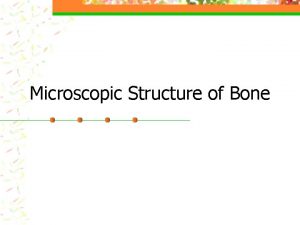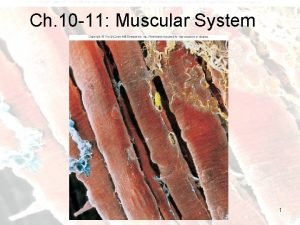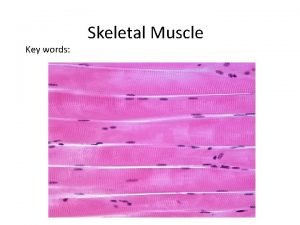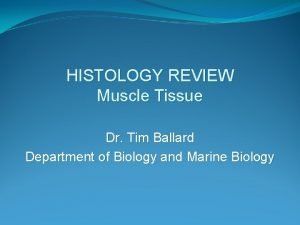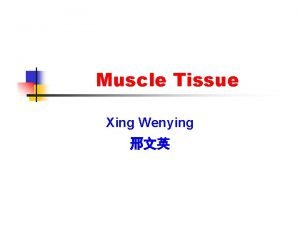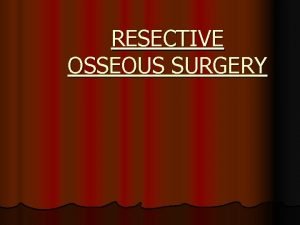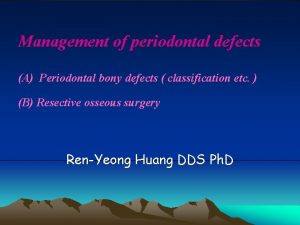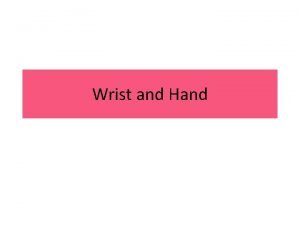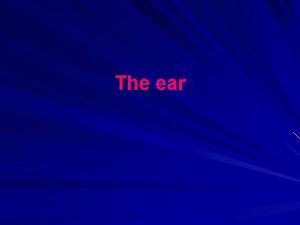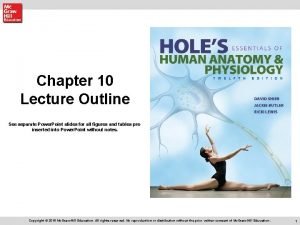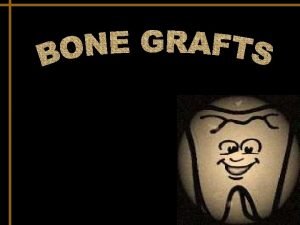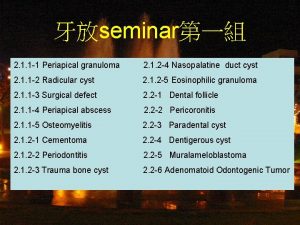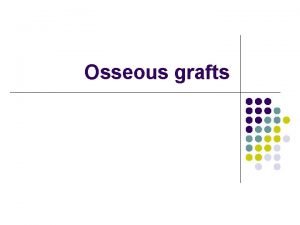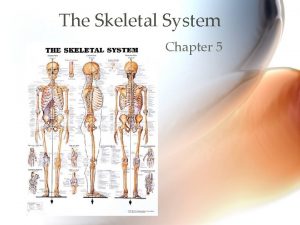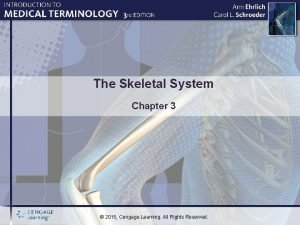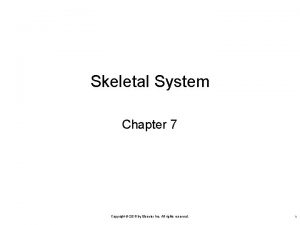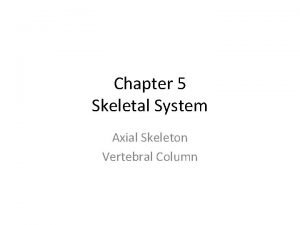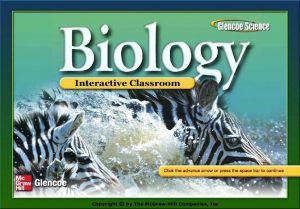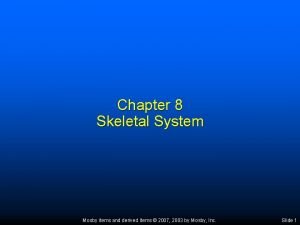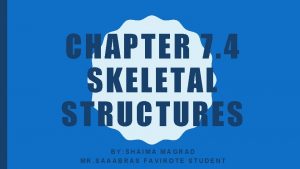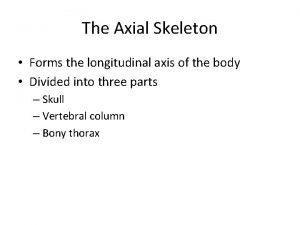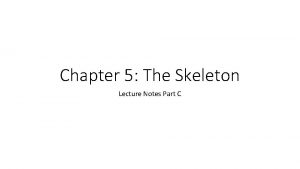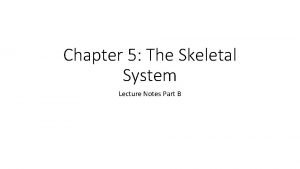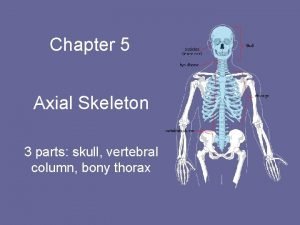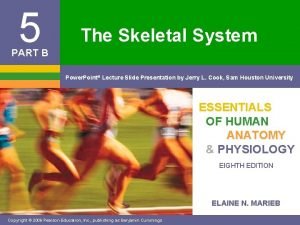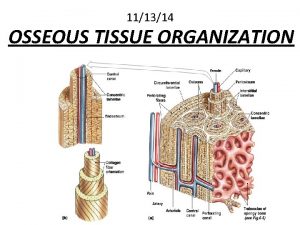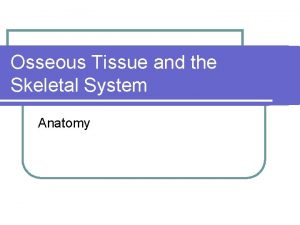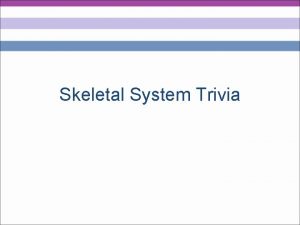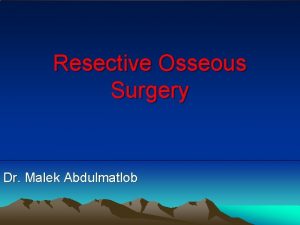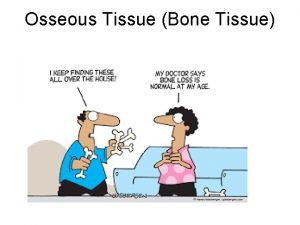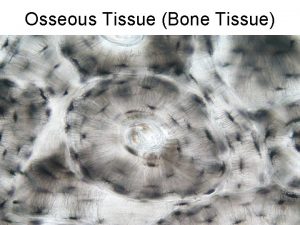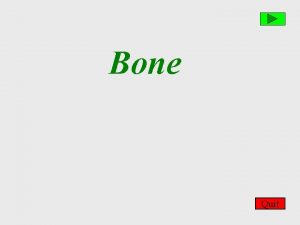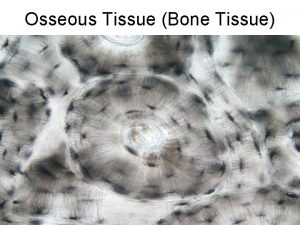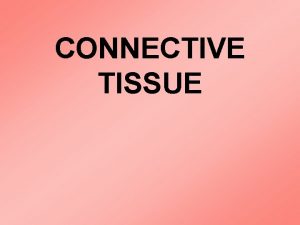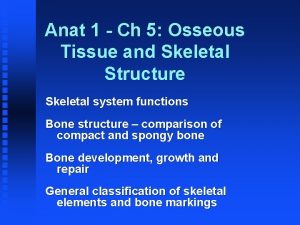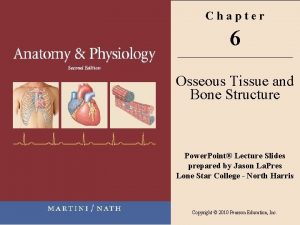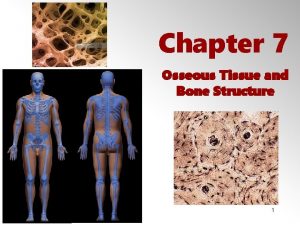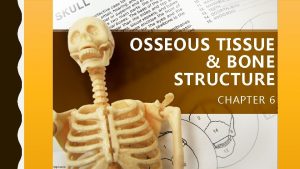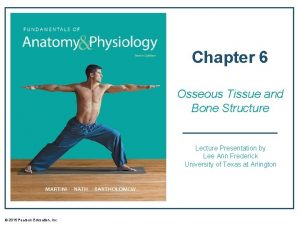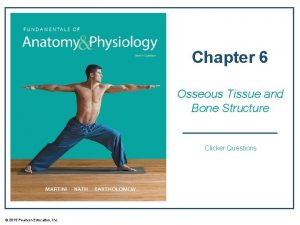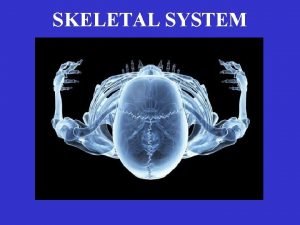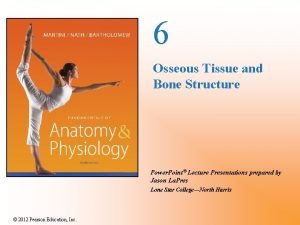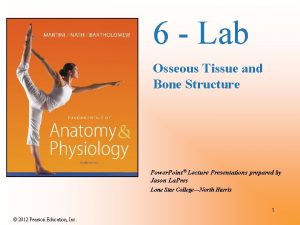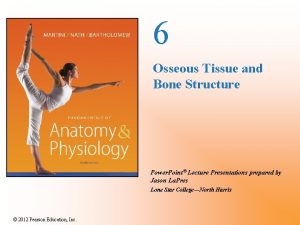The Skeletal System Osseous Tissue Skeletal Structure Chapter






























- Slides: 30

The Skeletal System. Osseous Tissue & Skeletal Structure Chapter 5

n The skeletal system includes: ¨ Bones ¨ Cartilage ¨ Joints ¨ Ligaments ¨ Other connective tissues

n Functions of the Skeletal System ¨ Support against gravity ¨ Protection of soft internal organs ¨ Movement (Leverage) ¨ Storage Minerals (calcium, phosphorous) – within the matrix of bone tissue n Energy reserve (adipose) – within the yellow marrow of long bones n ¨ Blood cell production – within red marrow of spongy bone tissue

The Structure of a Typical Bone n All bones have a combination of spongy (cancellous) & compact (dense) bone tissue

The Histological Features of Spongy Bone Lamellae (layers) of matrix laid down in trabeculae - branching network of bony tissue ¨ Osteocytes located within lacunae ¨ Canaliculi branch out from lacunae ¨ Many marrow cavities which contain red marrow & small blood vessels ¨

The Histological Features of Compact Bone n Osteon/Haversian system - basic functional unit of compact bone Concentric lamellae (layers) of matrix surrounding central (Haversian) canal Osteocytes located within lacunae Canaliculi branch out radially from lacunae Central canals (containing BVs) run vertically down the length of the bone Perforating (Volkmann’s) canals (containing BVs) run horizontally across the width

Bone Cells n In addition to Osteocytes, the mature bone cells found within the matrix of bone tissue, there are three other cells that are associated with bones ¨ Osteoprogenitor cells ¨ Osteoblasts ¨ Osteoclasts

Bone Cells n Osteoprogenitor cells ¨ Derived from mesenchymal cells ¨ Can undergo mitosis ¨ Mature into osteoblasts

Bone Cells n Osteoblasts ¨ Responsible for osteogenesis – create bone tissue ¨ Mature into osteocytes

Bone Cells n Osteoclasts ¨ Derived from embryological WBCs ¨ Secrete enzymes for osteolysis – resorb/break down bone tissue ¨ Necessary for calcium homeostasis

Anatomical Classification of Bones are classified by their basic shape Flat bones Sutural bones Irregular bones Long bones Short bones Sesamoid bones

Structure of a Typical Long Bone diaphysis (compact bone)

The Structure of a Long Bone epiphysis (spongy bone) diaphysis epiphysis

The Structure of a Long Bone articular cartilage epiphysis diaphysis articular cartilage epiphysis

The Structure of a Long Bone epiphysis metaphysis – location of • epiphyseal plate – in children • epiphyseal line – in adults diaphysis metaphysis epiphysis articular cartilage

The Structure of a Long Bone medullary cavity • filled with yellow marrow in adults • lined with endosteum

The Structure of a Long Bone §Double layered membrane surrounding bone except at articular cartilage §Inner cellular layer contains osteoprogenitor cells, osteoblasts, osteoclasts; therefore functions in bone growth & repair periosteum §Outer fibrous layer of dense irregular CT for attachment of tendons& ligaments; provides route for blood vessels & nerves; separates bone tissue from surrounding tissues

Bone Formation and Growth n Ossification - Process of converting other tissues to bone; begins around week 6 -8 of embryological development as mesenchymal CT begins to differentiate Two types of ossification processes occur during embryological formation: • Intramembranous • Endochondral

Intramembranous Ossification ¨ ¨ ¨ Forms flat bones of skull, mandible, clavicle Replacement of mesenchymal membrane with osseous tissue Mesenchymal cells differentiate to osteoprogenitor cells, which then become osteoblasts Osteoblasts create spongy bone tissue, which then remodels into compact bone where necessary Other mesenchymal cells around the developing bone form the periosteum Mesenchymal tissue forms Osteoblasts begin to secrete osteoid forming spongy bone tissue Blood vessels infiltrate tissue. Calcium salts deposit in osteoid. Periosteum develops

Endochondral Ossification Most bones formed this way ¨ Mesenchyme creates hyaline Cartilage model, which gets replaced by bone ¨ Replacement begins in middle (diaphysis) & follows in ends (epiphyses) ¨

Endochondral Ossification Cartilage model grows in length (interstitial growth) & in width (appositional growth) Chondrocytes at the center of the growing cartilage model enlarge and then die as the matrix calcifies. Cartilage model Copyright © 2007 Pearson Education, Inc. , publishing as Benjamin Cummings

Newly derived osteoblasts cover the shaft of the cartilage in a thin layer of bone. Chondrocytes at the center of the growing cartilage model enlarge and then die as the matrix calcifies. Enlarging chondrocytes within calcifying matrix Epiphysis Diaphysis The perichondrium, which surrounded the cartilage model, now must be referred to as the periosteum. Bone formation Cartilage model Figure 5. 7 Copyright © 2007 Pearson Education, Inc. , publishing as Benjamin Cummings

Chondrocytes at the center of the growing cartilage model enlarge and then die as the matrix calcifies. Blood vessels penetrate the dying cartilage. Newly developed osteoblasts form a primary ossification center. Newly derived osteoblasts cover the shaft of the cartilage in a thin layer of bone. Enlarging chondrocytes within calcifying matrix Epiphysis Diaphysis Marrow cavity Primary ossification center Bone formation Blood vessel Cartilage model Figure 5. 7 Copyright © 2007 Pearson Education, Inc. , publishing as Benjamin Cummings

Chondrocytes at the center of the growing cartilage model enlarge and then die as the matrix calcifies. Newly derived osteoblasts cover the shaft of the cartilage in a thin layer of bone. Blood vessels penetrate the cartilage. New osteoblasts form a primary ossification center. Enlarging chondrocytes within calcifying matrix Epiphysis Diaphysis Marrow cavity Primary ossification center Bone formation Blood vessel Cartilage model Marrow cavity Blood vessel Bone tissue continues to replace cartilage of the diaphysis, and & continues toward each epiphysis. The medullary cavity begins to hollow out Figure 5. 7 Copyright © 2007 Pearson Education, Inc. , publishing as Benjamin Cummings

Blood vessels invade the epiphyses and osteoblasts form secondary centers of ossification. Cartilage remains only at the ends (articular cartilage) & at metaphysis (epiphyseal plate) Chondrocytes at the center of the growing cartilage model enlarge and then die as the matrix calcifies. Newly derived osteoblasts cover the shaft of the cartilage in a thin layer of bone. Blood vessels penetrate the cartilage. New osteoblasts form a primary ossification center. The bone of the shaft thickens, and the cartilage near each epiphysis is replaced by shafts of bone. Articular cartilage Enlarging chondrocytes within calcifying matrix Epiphysis Diaphysis Epiphyseal cartilage Marrow cavity Primary ossification center Bone formation Cartilage model Blood vessel Marrow cavity Blood vessel Secondary ossification center

An Overview of the Skeleton There are 206 bones in the adult human body Skeletal Divisions n n Axial skeleton (80 bones) ¨ Skull ¨ Thoracic cage and sternum ¨ Vertebral column Appendicular skeleton (126 bones) ¨ Upper, lower limbs ¨ Pectoral girdle ¨ Pelvic girdle

Bone Markings (Surface Features) Table 5 -1 General elevations & projections: § process § ramus Markings for articulations: § § § head condyle facet

Bone Markings (Surface Features) Processes for attachment: trochanter (femur only) tuberosity Transverse tubercle process epicondyle crest line spinous process (vertebrae only) § transverse process (vertebrae only) § § § § Spinous process

Bone Markings (Surface Features) Depressions: §fossa §sulcus Spinous process Transverse process Openings: §foramen (canal) §meatus §fissure §sinus

Bone Markings (Surface Features)
 Osseous
Osseous Skeletal muscle tissue structure
Skeletal muscle tissue structure Skeletal muscle tissue description
Skeletal muscle tissue description Cross section of skeletal muscle
Cross section of skeletal muscle Transverse tubule
Transverse tubule How is aerolar tissue different than aerenchyma tissue?
How is aerolar tissue different than aerenchyma tissue? Osseous resective surgery
Osseous resective surgery Gradualizing marginal bone flat
Gradualizing marginal bone flat Synovial flexor sheath
Synovial flexor sheath Mastoid air cells
Mastoid air cells Osseous meatus
Osseous meatus Bone swaging
Bone swaging Lateral periodontal cyst
Lateral periodontal cyst Dfdba
Dfdba Chapter 5 the skeletal system
Chapter 5 the skeletal system Chapter 3 the skeletal system labeling exercises
Chapter 3 the skeletal system labeling exercises Elsevier
Elsevier Chapter 5 the skeletal system
Chapter 5 the skeletal system Chapter 6 the skeletal system answer key
Chapter 6 the skeletal system answer key Lamina bone
Lamina bone Chapter 32 section 2 the skeletal system answer key
Chapter 32 section 2 the skeletal system answer key Chapter 8 skeletal system
Chapter 8 skeletal system 7:4 skeletal system
7:4 skeletal system Axial skull
Axial skull The axial skeleton forms the longitudinal axis of the body
The axial skeleton forms the longitudinal axis of the body Typical vertebra superior view
Typical vertebra superior view Chapter 5 the skeletal system figure 5-10
Chapter 5 the skeletal system figure 5-10 Chapter 5 the skeletal system
Chapter 5 the skeletal system Axial skeleton
Axial skeleton Chapter 3 the skeletal system labeling exercises
Chapter 3 the skeletal system labeling exercises Hollow portions of bones surrounding the nasal cavity
Hollow portions of bones surrounding the nasal cavity
